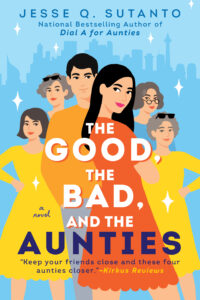Years ago, I was describing the Lunar New Year celebrations to a friend of mine. I told her how huge my family is—my father has six siblings, my mother has eight, and every single sibling had multiple children, which means I have seventeen first cousins on my father’s side, twenty-five on my mom’s side, and too many nieces and nephews to count. During Lunar New Year, or as we call it within the Chinese community—Chinese New Year, we gather and give hong baos—red packets—to children and unmarried relatives, and it is utter chaos.
We all have varying levels of organization when it comes to the red packets. Some of my more organized relatives actually specify each individual niece and nephew’s name on the red packets. I’m more chaotic, so I just write down “G4,” short for “4th Generation” for my nieces and nephews and they each get the same amount of money because I can hardly keep track of my own kiddos, let alone my cousins’. And the whole thing is rife with landmines.
Our first year after we got married, my husband and I gave too little in the red packets; what my mom later told us was an “offensive” amount. Mortified, we over-compensated and gave way too much in the second year; what my mom said was a “showing off” amount. It took a couple more years after that to gauge what was an appropriate amount of money to put into those red packets.
Anyway, I was telling my friend this, and she said, “It would be hilarious if you set an Aunties book during Chinese New Year, and the wrong red packet got given to the wrong person.” I was floored. What an utterly perfect setting for the third and final installment of the Aunties series! After all, the Dial A for Aunties brand is known for its comical chaos.
As I began to plot The Good, The Bad, and The Aunties, I learned quite a few lessons on how to turn a holiday into the setting for a crime novel. The first thing I did was to make a list of my favorite parts of the holiday. My favorite part of Chinese New Year is getting to see all of my extended family members together at once. Because of how huge my family is, it’s rare that we all get together, and I love the noise of having everyone be in the same space. My second favorite part is the food. Despite there being so many of us there, somehow there is always so much food that we can never finish it all. My third favorite part is all of the cultural traditions—the giving out of red packets, the wearing of auspicious colors like red or gold, the well wishes that we have to recite upon seeing one another, the mixing of the yu sheng—a fish salad that everyone has to mix together using extra long chopsticks to ring in a fortuitous year ahead.
Once I had all of these highlights, I then focused on how the crime, in this case illicit businesses and kidnapping, can fit into the holiday. My friend had come up with the brilliant suggestion of having a specific red packet go to the wrong recipient, so I considered what could be in that red packet, and who it was meant for, and whose hands it might fall into. And what would be the consequences of that mistake? Then, I focused on how the characters could use the CNY celebrations to their advantage, how they might sneak into places they wouldn’t otherwise have access to and how the chaos of the holiday would work in their favor.
Something that has given me great joy with the Aunties books is the ability to share my culture with the world. I moved to California when I was sixteen, and I found out to my surprise that many people had no idea what Lunar New Year is and how in many Asian cultures, it is the biggest holiday that we celebrate. As I wrote The Good, The Bad, and The Aunties, I treated it as a big celebration that everyone is invited to, and I’m so happy that we get to close the series with such a bang.
***


















